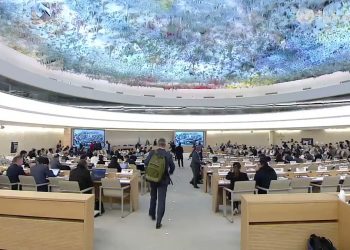Human Lives Human Rights: The word “Holocaust,” is deriverd from two the Greek words “holos” (whole) and “kaustos” (burned), which was historically used to describe a sacrificial offering burned on an altar. Since 1945, the word has taken on a new and terrifying meaning: the ideological and systematic state-sponsored persecution and mass murder of millions of European Jews (as well as millions of others, including Romans, mentally disabled, dissidents and homosexuals) Nazi regime in Germany between 1933 and 1945.
According to the anti-Semitic Nazi leader Adolf Hitler, Jews were an inferior race, an alien threat to German racial purity and community. After years of Nazi rule in Germany, during which Jews were consistently persecuted, Hitler’s “final solution”—now known as the Holocaust—came to fruition under the cover of World War II, with mass killing centers constructed in the concentration camps of occupied Poland. Nearly, six million Jews and some 5 million others, targeted for racial, political, ideological and behavioral reasons, died in the Holocaust. More than one million of those who perished were children.
Before the Holocaust: Historical anti-Semitism and Hitler’s rise to power
Anti-Semitism in Europe did not begin with Adolf Hitler. Though use of the term itself dates only to the 1870s, there is evidence of hostility toward Jews long before the Holocaust–even as far back as the ancient world, when Roman authorities destroyed the Jewish temple in Jerusalem and forced Jews to leave Palestine. The Enlightenment, during the 17th and 18th centuries, emphasized religious toleration, and in the 19th century Napoleon and other European rulers enacted legislation that ended long-standing restrictions on Jews. However, anti-Semitism persisted, in many cases taking on a racial rather than a religious character.
The roots of Hitler’s particularly virulent brand of anti-Semitism are unclear. Born in Austria in 1889, he served in the German army during World War I. Like many anti-Semites in Germany, he blamed the Jews for the country’s defeat in 1918. Soon after the war ended, Hitler joined the National German Workers’ Party, which became the National Socialist German Workers’ Party (NSDAP), known to English speakers as the Nazis. While imprisoned for treason for his role in the Beer Hall Putsch of 1923, Hitler wrote the memoir and propaganda tract “Mein Kampf” (My Struggle), in which he predicted a general European war that would result in “the extermination of the Jewish race in Germany.”
Hitler was obsessed with the idea of the superiority of the “pure” German race, which he called “Aryan,” and with the need for “Lebensraum,” or living space, for that race to expand. In the decade after he was released from prison, Hitler took advantage of the weakness of his rivals to enhance his party’s status and rise from obscurity to power. On January 30, 1933, he was named chancellor of Germany. After the death of President Paul von Hindenburg’s in 1934, Hitler anointed himself as “Fuhrer,” becoming Germany’s supreme ruler.
Nazi Revolution in Germany, 1933-1939
The dual goals of racial purity and spatial expansion were the core of Hitler’s worldview, and from 1933 onward they merged to form the driving force behind his foreign and domestic policy. The Nazis initially reserved their harshest persecution for political opponents such as Communists or Social Democrats. The first official concentration camp opened at Dachau (near Munich) in March 1933, and many of the first prisoners sent there were Communists.
Like the network of concentration camps that followed, becoming the killing grounds of the Holocaust, Dachau was under the control of Heinrich Himmler, head of the elite Nazi guard, the Schutzstaffel (SS), and later chief of the German police. As of July 1933, German concentration camps (Konzentrationslager in German, or KZ) held about 27,000 people in “protective custody.” Huge Nazi rallies and symbolic acts such as the public burning of books by Jews, Communists, liberals and foreigners helped drive home the desired message of party’s strength.
In 1933, Jews in Germany made up about 525,000 people, or only 1% of the total German population. Over the next six years, the Nazis undertook an “Aryanization” of Germany. They expelled non-Aryans from government service, disbanded Jewish-owned businesses, and barred Jewish lawyers and physicians from their clients. Under the Nuremberg Laws of 1935, anyone with three or four Jewish grandparents was considered a Jew, while those who had two Jewish grandparents were designated Mischlinge (half-breeds).
Under the Nuremberg Laws, Jews became routine targets for stigmatization and persecution. This culminated in Kristallnacht, or the “night of broken glass” in November 1938, when German synagogues were burned and windows in Jewish shops were smashed; some 100 Jews were killed and thousands more were detained. From 1933 to 1939, hundreds of thousands of Jews who were able to leave Germany did, while those who remained lived in a constant state of uncertainty and fear.
Beginning of War, 1939-1940
In September 1939, the German army occupied the western half of Poland. German police soon forced tens of thousands of Polish Jews from their homes and into ghettoes, giving their confiscated properties to ethnic Germans (non-Jews outside Germany who were identified as German), Germans from the Reich or Polish gentiles. Surrounded by high walls and barbed wire, the Jewish ghettoes in Poland functioned like captive city-states, governed by Jewish Councils. In addition to widespread unemployment, poverty and hunger, overpopulation made the ghettoes breeding grounds for disease such as typhus.
Meanwhile, beginning in the fall of 1939, Nazi officials selected around 70,000 Germans institutionalized for mental illness or disabilities to be gassed to death in the so-called Euthanasia Program. After prominent German religious leaders protested, Hitler put an end to the program in August 1941, though killings of the disabled continued in secrecy, and by 1945 some 275,000 people deemed handicapped from all over Europe had been killed. In hindsight, it seems clear that the Euthanasia Program functioned as a pilot for the Holocaust.


















